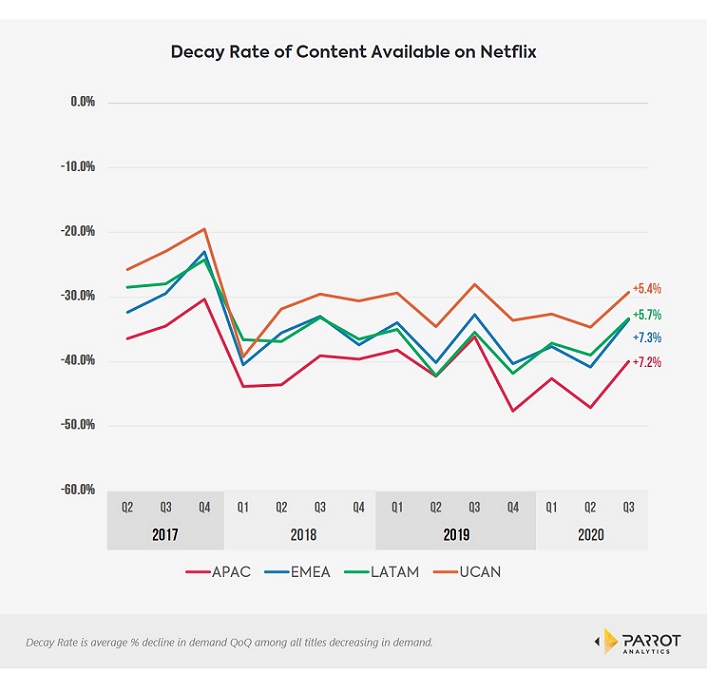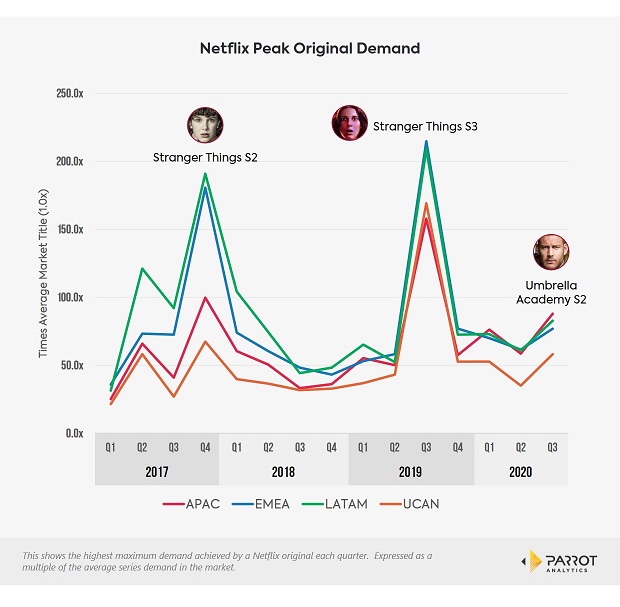 In their recently-released Q3 2020 earnings report, Netflix added 2.2M global net subscribers. This figure is just shy of their estimated gain for the quarter of 2.5M. Additionally, it fell short of analyst expectations that forecast the service’s growth in subscriber numbers would exceed Netflix’s own guidance. Accordingly, the company’s share price was down about 5% after market close. This is not the first time Netflix has faced challenges maintaining subscriber growth.
In their recently-released Q3 2020 earnings report, Netflix added 2.2M global net subscribers. This figure is just shy of their estimated gain for the quarter of 2.5M. Additionally, it fell short of analyst expectations that forecast the service’s growth in subscriber numbers would exceed Netflix’s own guidance. Accordingly, the company’s share price was down about 5% after market close. This is not the first time Netflix has faced challenges maintaining subscriber growth.
However, while the main metric of paid net adds may have fallen short, in many ways this has been a solid quarter for Netflix. The effects of the ongoing extraordinary operating conditions caused by the global pandemic are likely still benefitting the streamer.
One such effect is shown below, where we can see that in Q3 more titles are trending positive in demand across all regions. About half of all Netflix original titles saw QoQ increases in demand. The USCAN region in particular saw its share of titles trending upward increase by nearly 15%.

In another positive indicator, the decay rate of content on Netflix is improving across regions. This shows that demand for content available on Netflix is holding up better over time. This is good news for those who had concerns about audiences burning through content faster during lockdowns and bodes well for subscriber retention.
We know that tentpole originals are key drivers of subscriptions. Netflix itself, likely aware that the absence of these is keenly felt, reassured investors that tentpoles were coming, calling out specifically in the shareholder letter that production has restarted on Stranger Things S4 and The Witcher S2.

The chart below shows how demand for tentpole originals is a leading indicator of subscriber net adds. In the chart, demand has been forward shifted by one quarter to better show its predictive relationship with subscribers. Aside from the difference in Q1 2020, driven by the pandemic and catching everyone including Netflix by surprise, a previous quarter’s change in demand is a good indicator of subscriber growth. Demand for tentpole originals in one quarter drives subscriber growth in the next.
We’ve included Netflix’s Q1 2020 guidance in the chart above as an estimate of where net adds would have been in the absence of pandemic effects. As can be seen, Q4 2019’s sharp decline in original tentpole demand would have been in line with Netflix’s guidance which had forecast global subscriber growth slowing in the first quarter of 2020. Following the anomaly that was the first quarter this year, it appears that the historical relationship between a previous quarter’s tentpole demand and current subscriber growth has resumed. The Q2 2020 reduction in demand for Netflix tentpole originals presaged Q3’s slowdown in subscriber numbers.

Beyond tentpoles being a driver for subscriber acquisition, two genres in particular are key in supporting subscriber acquisition – children’s and drama. We’ve previously shown the power of these genres for adding subscribers.
In dramas, a critical genre to lure subscribers and one in which Netflix has had historical strength, Netflix originals are losing share slightly in APAC and LATAM so far this year, down 2.7% and 1.8% respectively. A powerful force to reverse this trend would be another season of one of their tentpole dramas such as Stranger Things.
The above demand share analysis also reflects the competitive headwinds Netflix faces as new streamers enter the market. Peacock and HBO Max’s launches earned a mention in this quarter’s shareholder letter. Disney’s reorganization to focus on streaming was also specifically addressed. Netflix is certainly aware that the streaming wars are far from finished.
Source:Parrot Analytics


